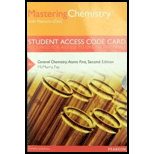
(a)
Interpretation:
The energy band for molecular orbital and electron population of a semiconductor has to be drawn. Also higher electrical conductivity of semiconductor than insulator has to be explained.
Concept introduction:
Semiconductor: A material which can conduct electricity in range between a metal and an insulator is known as semiconductor. Addition of small amount of impurities increases conductivity of semiconductor and the process is known as doping. n-type and p-type are two types of doped semiconductors.
n-type: This type of doped semiconductor is the one in which many free electrons are present in conduction band.
p-type: This type of doped semiconductor is the one in which holes are present in conduction band.
(b)
Interpretation:
The energy band for molecular orbital and electron population of an insulator has to be drawn.
Concept introduction:
Insulator:
Insulators are the one in which electrons are filled in valence band with a vacant conduction band and they are parted away by band gap.
Want to see the full answer?
Check out a sample textbook solution
Chapter 21 Solutions
Masteringchemistry with Pearson Etext -- Standalone Access Code Card -- For General Chemistry
- a) Explain the band structure of an electrical conductor (metal), a semiconductor, and an insulator at 0 K by showing the valence and conduction bands and fermi energy levels. Explain how the electrical conduction takes place in these three types of materials. Give an example for each type of material. b)Explain what n and p-type semiconductors are using their band structures. Why?arrow_forwardIndicate which of the following statements are true with regard to semiconductors. (a) elemental semiconductors are made of metalloids (b) semiconductors have a band gap that is greater than 3.5 eV (c) doping a semiconductor with a few ppm of a p block element increases the conductivity of that material by a million fold (d) compound semiconductors must contain at least one metalloid elementarrow_forwardThe angle of diffraction of (220) set of planes for an FCC element occurs at 69.22° when monochromatic x-radiation having a wavelength of 0.1542 nm is used. (a) Calculate the atomic radius of the element; (b) Calculate the angle of diffraction from the set of planes (310).arrow_forward
- Identify the following as either p- or n- type semiconductors.(a) germanium doped with arsenic(b) silicon doped with phosphorus(c) germanium doped with indium(d) germanium doped with antimonyarrow_forward2. What is the coordination number structure formed by most semiconductors and electronic materials (GaAs, Cds)arrow_forwardThe maximum wavelength of light that a certain silicon photocell can detect is 1.11 μm. (a) What is the energy gap (in electron volts) between the valence and conduction bands for this photocell? (b) Explain why pure silicon is opaque.arrow_forward
- (c) Explain what happens when a pure semiconductor made up of Silicon is doped with an Indium atom during manufacture. Explain on the availability of the Carriers created as a result of this doping with the help of a neat sketch.arrow_forwardWhat do Doped semiconductors contain?arrow_forwardWhat are n-type semiconductors?arrow_forward
- Predict the structure of each of the following silicate minerals (network, sheets, double chains, and so forth). Give the oxidation state of each atom.(a) Apophyllite, KCa4(Si8O20)F ? 8 H2O(b) Rhodonite, CaMn4(Si5O15)(c) Margarite, CaAl2(Al2Si2O10)(OH)2arrow_forwardWhat is the difference in energy between the valence band and conduction band of electrical conductors, semiconductors and insulators? Explain in scheme and give at least one example for each of that three types materials.arrow_forwardCarbon exists as several allotropes including buckminsterfullerene and carbonnanotubes. All are composed of pure carbon, but their materials properties differdramatically due to the different arrangements of atoms in their structures. Name TWO(2) other allotropes and compare both of them in terms of:i) crystal structure with a suitable diagram.ii) electrical propertiesarrow_forward
 Physical ChemistryChemistryISBN:9781133958437Author:Ball, David W. (david Warren), BAER, TomasPublisher:Wadsworth Cengage Learning,
Physical ChemistryChemistryISBN:9781133958437Author:Ball, David W. (david Warren), BAER, TomasPublisher:Wadsworth Cengage Learning, Principles of Modern ChemistryChemistryISBN:9781305079113Author:David W. Oxtoby, H. Pat Gillis, Laurie J. ButlerPublisher:Cengage Learning
Principles of Modern ChemistryChemistryISBN:9781305079113Author:David W. Oxtoby, H. Pat Gillis, Laurie J. ButlerPublisher:Cengage Learning Chemistry: The Molecular ScienceChemistryISBN:9781285199047Author:John W. Moore, Conrad L. StanitskiPublisher:Cengage Learning
Chemistry: The Molecular ScienceChemistryISBN:9781285199047Author:John W. Moore, Conrad L. StanitskiPublisher:Cengage Learning


